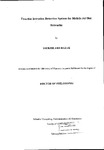Two-tier Intrusion Detection System for Mobile Ad Hoc Networks
| dc.contributor.author | RAZAK, SHUKOR ABD | |
| dc.contributor.other | School of Engineering, Computing and Mathematics | en_US |
| dc.date.accessioned | 2013-10-11T08:48:14Z | |
| dc.date.available | 2013-10-11T08:48:14Z | |
| dc.date.issued | 2007 | |
| dc.identifier | NOT AVAILABLE | en_US |
| dc.identifier.uri | http://hdl.handle.net/10026.1/2162 | |
| dc.description.abstract |
Nowadays, a commonly used wireless network (i.e. Wi-Fi) operates with the aid of a fixed infrastructure (i.e. an access point) to facilitate communication between nodes when they roam from one location to another. The need for such a fixed supporting infrastructure limits the adaptability of the wireless network, especially in situations where the deployment of such an infrastructure is impractical. In addition, Wi-Fi limits nodes' communication as it only provides facility for mobile nodes to send and receive information, but not reroute the information across the network. Recent advancements in computer network introduced a new wireless network, known as a Mobile Ad Hoc Network (MANET), to overcome these limitations. MANET has a set of unique characteristics that make it different from other kind of wireless networks. Often referred as a peer to peer network, such a network does not have any fixed topology, thus nodes are free to roam anywhere, and could join or leave the network anytime they desire. Its ability to be setup without the need of any infrastructure is very useful, especially in geographically constrained environments such as in a military battlefield or a disaster relief operation. In addition, through its multi hop routing facility, each node could function as a router, thus communication between nodes could be made available without the need of a supporting fixed router or an access point. However, these handy facilities come with big challenges, especially in dealing with the security issues. This research aims to address MANET security issues by proposing a novel intrusion detection system that could be used to complement existing prevention mechanisms that have been proposed to secure such a network. A comprehensive analysis of attacks and the existing security measures proved that there is a need for an Intrusion Detection System (IDS) to protect MANETs against security threats. The analysis also suggested that the existing IDS proposed for MANET are not immune against a colluding blackmail attack due to the nature of such a network that comprises autonomous and anonymous nodes. The IDS architecture as proposed in this study utilises trust relationships between nodes to overcome this nodes' anonymity issue. Through a friendship mechanism, the problems of false accusations and false alarms caused by blackmail attackers in global detection and response mechanisms could be eliminated. The applicability of the friendship concept as well as other proposed mechanisms to solve MANET IDS related issues have been validated through a set of simulation experiments. Several MANET settings, which differ from each other based on the network's density level, the number of initial trusted friends owned by each node, and the duration of the simulation times, have been used to study the effects of such factors towards the overall performance of the proposed IDS framework. The results obtained from the experiments proved that the proposed concepts are capable to at least minimise i f not fully eliminate the problem currently faced in MANET IDS. | en_US |
| dc.language.iso | en | en_US |
| dc.publisher | University of Plymouth | en_US |
| dc.title | Two-tier Intrusion Detection System for Mobile Ad Hoc Networks | en_US |
| dc.type | Thesis | |
| dc.identifier.doi | http://dx.doi.org/10.24382/3347 | |
| dc.identifier.doi | http://dx.doi.org/10.24382/3347 |
Files in this item
This item appears in the following Collection(s)
-
01 Research Theses Main Collection
Research Theses Main


